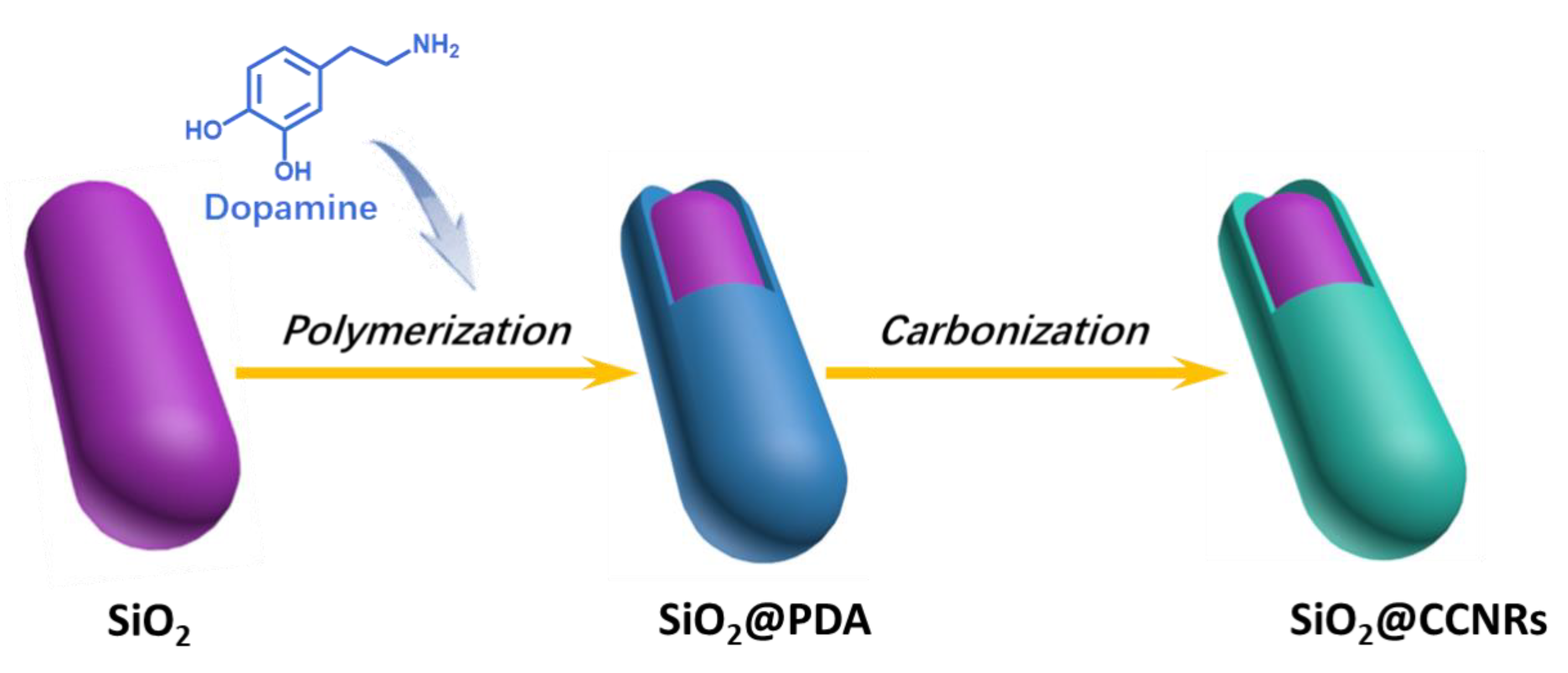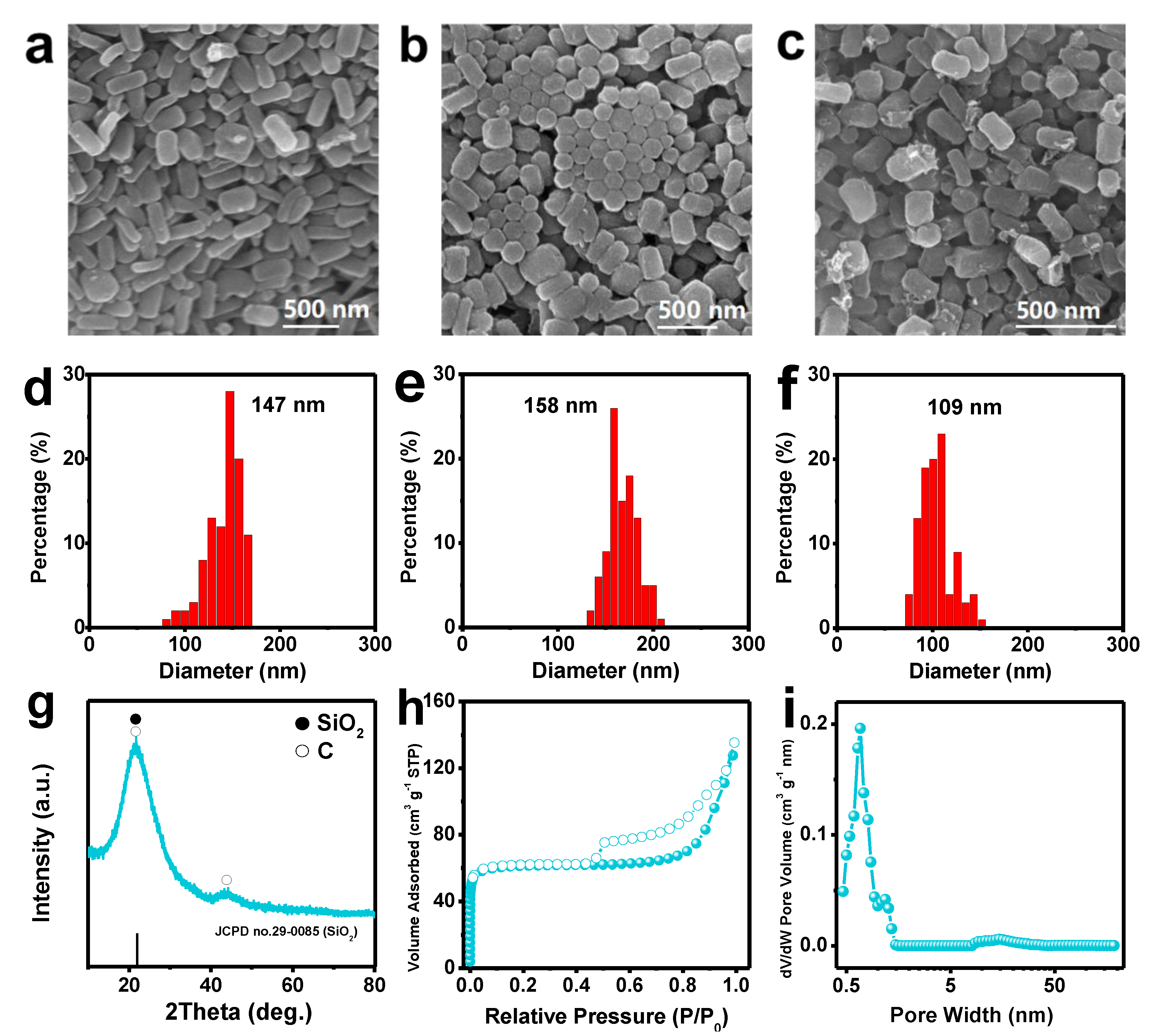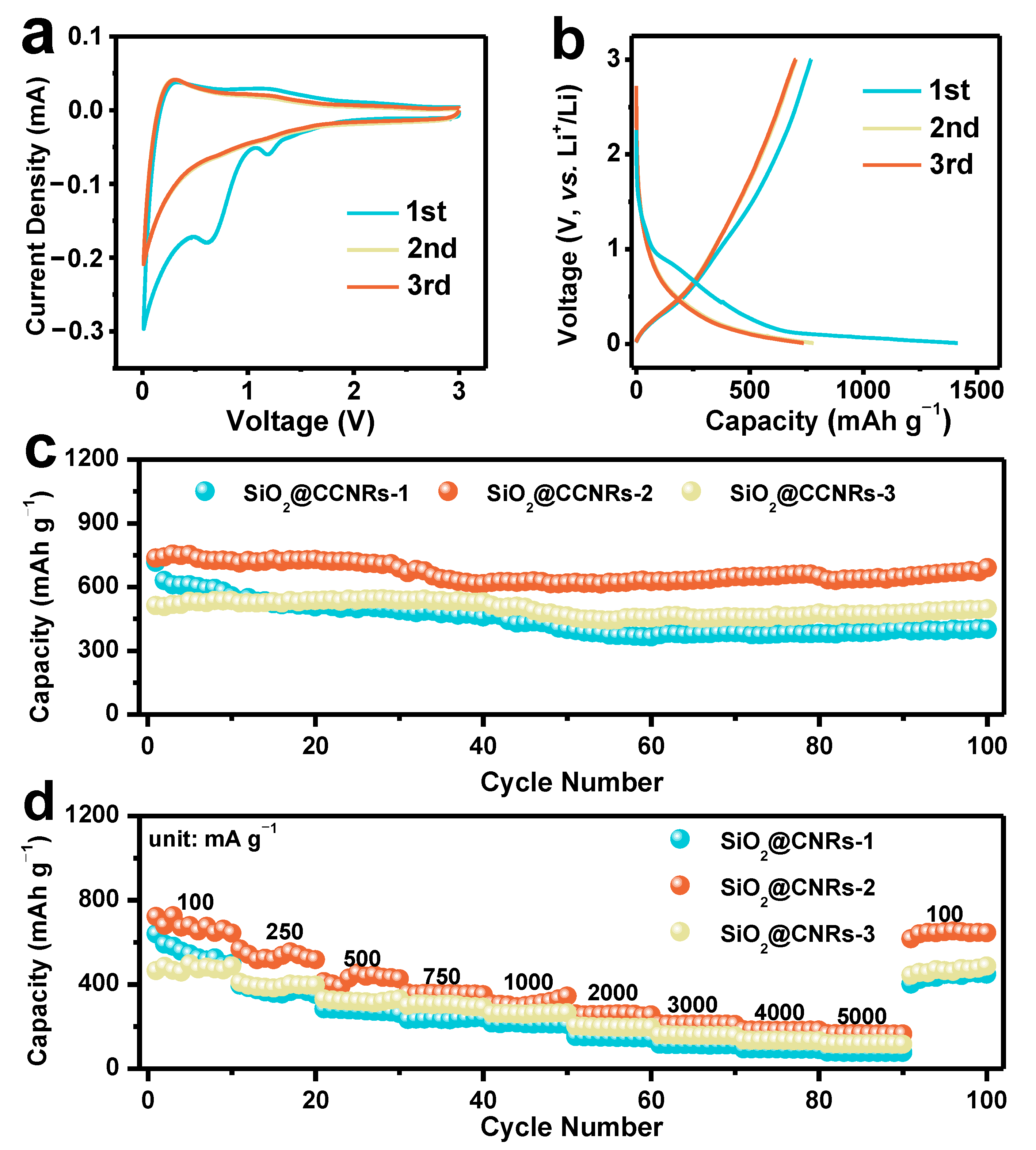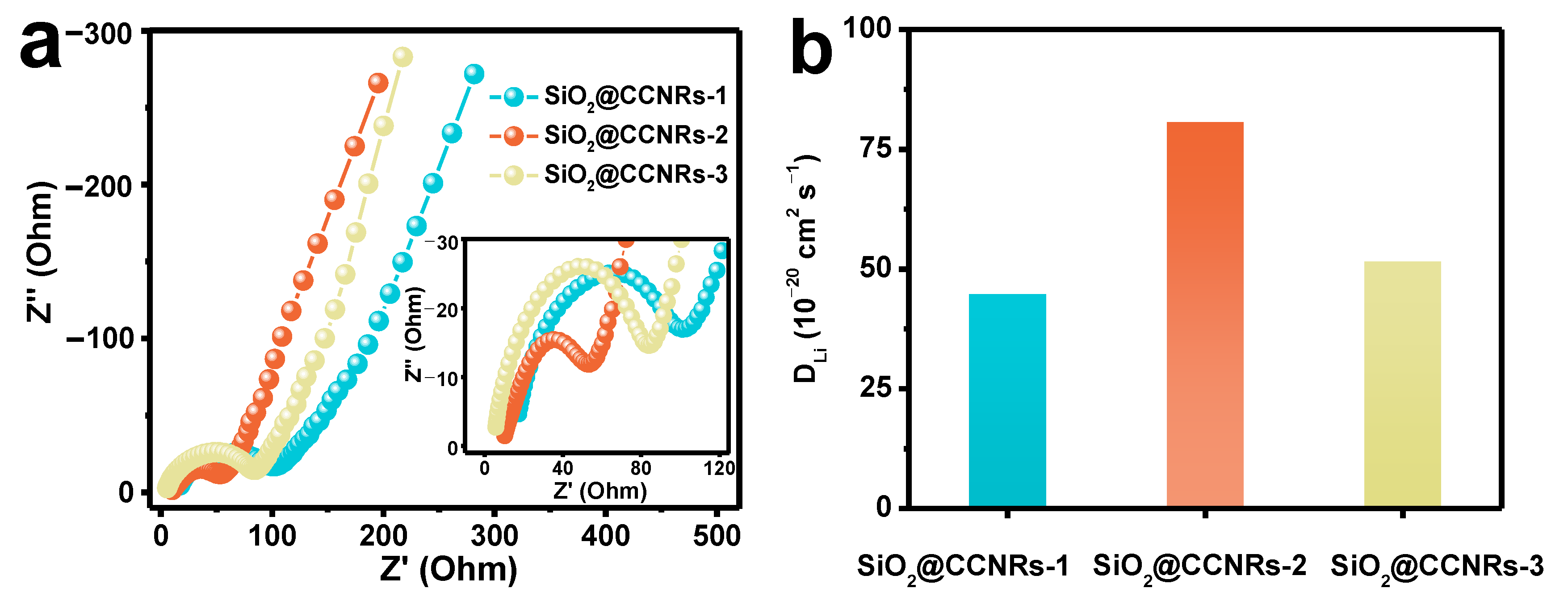Facile Synthesis of Core-Shell Structured SiO2@Carbon Composite Nanorods for High-Performance Lithium-Ion Batteries
Abstract
1. Introduction
2. Materials and Methods
2.1. Materials
2.2. Preparation of SiO2@Carbon Nanorods
2.2.1. Synthesis of SiO2 Nanorods
2.2.2. Synthesis of SiO2@Carbon Nanorods
2.3. Material Characterization
2.4. Electrochemical Measurements
3. Results
4. Conclusions
Supplementary Materials
Author Contributions
Funding
Conflicts of Interest
References
- Na, Z.L.; Huang, G.; Liang, F.; Yin, D.M.; Wang, L.M. A Core-Shell Fe/Fe2O3 Nanowire as a High-Performance Anode Material for Lithium-Ion Batteries. Chem. Eur. J. 2016, 22, 12081–12087. [Google Scholar] [CrossRef] [PubMed]
- Wang, K.; Pei, S.E.; He, Z.S.; Huang, L.A.; Zhu, S.S.; Guo, J.F.; Shao, H.B.; Wang, J.M. Synthesis of a novel porous silicon microsphere@carbon core-shell composite via in situ MOF coating for lithium ion battery anodes. Chem. Eng. J. 2019, 356, 272–281. [Google Scholar] [CrossRef]
- Meng, J.K.; Cao, Y.; Suo, Y.; Liu, Y.S.; Zhang, J.M.; Zheng, X.C. Facile Fabrication of 3D SiO2@Graphene Aerogel Composites as Anode Material for Lithium Ion Batteries. Electrochim. Acta 2015, 176, 1001–1009. [Google Scholar] [CrossRef]
- Andre, D.; Kim, S.J.; Lamp, P.; Lux, S.F.; Maglia, F.; Paschos, O.; Stiaszny, B. Future generations of cathode materials: An automotive industry perspective. J. Mater. Chem. A 2015, 3, 6709–6732. [Google Scholar] [CrossRef]
- Liang, Y.R.; Zhao, C.Z.; Yuan, H.; Chen, Y.; Zhang, W.C.; Haung, J.Q.; Yu, D.S.; Titirici, M.M.; Chueh, Y.L.; Yu, H.J.; et al. A review of rechargeable batteries for portable electronic devices. InfoMat 2019, 1, 6–32. [Google Scholar] [CrossRef]
- Ali, S.; Jaffer, S.; Maitlo, I.; Shehzad, F.K.; Wang, Q.Y.; Ali, S.; Akram, M.Y.; He, Y.; Nie, J. Photo cured 3D porous silica-carbon (SiO2-C) membrane as anode material for high performance rechargeable Li-ion batteries. J. Alloy. Compd. 2020, 812, 8. [Google Scholar] [CrossRef]
- Chang, W.S.; Park, C.M.; Kim, J.H.; Kim, Y.U.; Jeong, G.; Sohn, H.J. Quartz (SiO2): A new energy storage anode material for Li-ion batteries. Energy Environ. Sci. 2012, 5, 6895–6899. [Google Scholar] [CrossRef]
- Cao, L.M.; Huang, J.L.; Lin, Z.P.; Yu, X.; Wu, X.X.; Zhang, B.D.; Zhan, Y.F.; Xie, F.Y.; Zhang, W.H.; Chen, J.; et al. Amorphous SiO2/C composite as anode material for lithium-ion batteries. J. Mater. Res. 2018, 33, 1219–1225. [Google Scholar] [CrossRef]
- Yang, X.Q.; Ma, H.; Zhang, G.Q.; Li, X.X. Silica/Carbon Composites with Controllable Nanostructure from a Facile One-Step Method for Lithium-Ion Batteries Application. Adv. Mater. Interfaces 2019, 6, 7. [Google Scholar] [CrossRef]
- Yuan, Z.N.; Zhao, N.Q.; Shi, C.S.; Liu, E.Z.; He, C.N.; He, F. Synthesis of SiO2/3D porous carbon composite as anode material with enhanced lithium storage performance. Chem. Phys. Lett. 2016, 651, 19–23. [Google Scholar] [CrossRef]
- Lener, G.; Garcia-Blanco, A.A.; Furlong, O.; Nazzarro, M.; Sapag, K.; Barraco, D.E.; Leiva, E.P.M. A silica/carbon composite as anode for lithium-ion batteries with a large rate capability: Experiment and theoretical considerations. Electrochim. Acta 2018, 279, 289–300. [Google Scholar] [CrossRef]
- Xiao, T.T.; Zhang, W.F.; Xu, T.; Wu, J.X.; Wei, M.D. Hollow SiO2 microspheres coated with nitrogen doped carbon layer as an anode for high performance lithium-ion batteries. Electrochim. Acta 2019, 306, 106–112. [Google Scholar] [CrossRef]
- Xu, Q.; Sun, J.K.; Yin, Y.X.; Guo, Y.G. Facile Synthesis of Blocky SiOx/C with Graphite-Like Structure for High-Performance Lithium-Ion Battery Anodes. Adv. Funct. Mater. 2018, 28, 7. [Google Scholar] [CrossRef]
- Wang, C.W.; Liu, K.W.; Chen, W.F.; Zhou, J.D.; Lin, H.P.; Hsu, C.H.; Kuo, P.L. Mesoporous SiO2/carbon hollow spheres applied towards a high rate-performance Li-battery anode. Inorg. Chem. Front. 2016, 3, 1398–1405. [Google Scholar] [CrossRef]
- Lv, P.P.; Zhao, H.L.; Wang, J.; Liu, X.; Zhang, T.H.; Xia, Q. Facile preparation and electrochemical properties of amorphous SiO2/C composite as anode material for lithium ion batteries. J. Power Sources 2013, 237, 291–294. [Google Scholar] [CrossRef]
- Sun, Q.; Zhang, B.; Fu, Z.W. Lithium electrochemistry of SiO2 thin film electrode for lithium-ion batteries. Appl. Surf. Sci. 2008, 254, 3774–3779. [Google Scholar] [CrossRef]
- Yan, N.; Wang, F.; Zhong, H.; Li, Y.; Wang, Y.; Hu, L.; Chen, Q.W. Hollow Porous SiO2 Nanocubes Towards High-performance Anodes for Lithium-ion Batteries. Sci. Rep. 2013, 3, 6. [Google Scholar] [CrossRef]
- Ma, X.M.; Wei, Z.P.; Han, H.J.; Wang, X.B.; Cui, K.Q.; Yang, L. Tunable construction of multi-shell hollow SiO2 microspheres with hierarchically porous structure as high-performance anodes for lithium ion batteries. Chem. Eng. J. 2017, 323, 252–259. [Google Scholar] [CrossRef]
- Tu, J.G.; Yuan, Y.; Zhan, P.; Jiao, H.D.; Wang, X.D.; Zhu, H.M.; Jiao, S.Q. Straightforward Approach toward SiO2 Nanospheres and Their Superior Lithium Storage Performance. J. Phys. Chem. C 2014, 118, 7357–7362. [Google Scholar] [CrossRef]
- Favors, Z.; Wang, W.; Bay, H.H.; George, A.; Ozkan, M.; Ozkan, C.S. Stable Cycling of SiO2 Nanotubes as High-Performance Anodes for Lithium-Ion Batteries. Sci. Rep. 2014, 4, 7. [Google Scholar] [CrossRef]
- Yao, Y.; Zhang, J.J.; Xue, L.G.; Huang, T.; Yu, A.S. Carbon-coated SiO(2) nanoparticles as anode material for lithium ion batteries. J. Power Sources 2011, 196, 10240–10243. [Google Scholar] [CrossRef]
- Guo, B.K.; Shu, J.; Wang, Z.X.; Yang, H.; Shi, L.H.; Liu, Y.N.; Chen, L.Q. Electrochemical reduction of nano-SiO2 in hard carbon as anode material for lithium ion batteries. Electrochem. Commun. 2008, 10, 1876–1878. [Google Scholar] [CrossRef]
- Liu, X.L.; Chen, Y.X.; Liu, H.B.; Liu, Z.Q. SiO2@C hollow sphere anodes for lithium-ion batteries. J. Mater. Sci. Technol. 2017, 33, 239–245. [Google Scholar] [CrossRef]
- Liang, Y.R.; Zhang, W.C.; Wu, D.C.; Ni, Q.Q.; Zhang, M.Q. Interface Engineering of Carbon-Based Nanocomposites for Advanced Electrochemical Energy Storage. Adv. Mater. Interfaces 2018, 5, 1800430. [Google Scholar] [CrossRef]
- Li, H.H.; Zhang, L.L.; Fan, C.Y.; Wang, K.; Wu, X.L.; Sun, H.Z.; Zhang, J.P. A plum-pudding like mesoporous SiO2/flake graphite nanocomposite with superior rate performance for LIB anode materials. Phys. Chem. Chem. Phys. 2015, 17, 22893–22899. [Google Scholar] [CrossRef] [PubMed]
- Shi, J.W.; Gao, H.Y.; Hu, G.X.; Zhang, Q. Core-shell structured Si@C nanocomposite for high-performance Li-ion batteries with a highly viscous gel as precursor. J. Power Sources 2019, 438, 9. [Google Scholar] [CrossRef]
- Jiao, M.L.; Liu, K.L.; Shi, Z.Q.; Wang, C.Y. SiO2/Carbon Composite Microspheres with Hollow Core-Shell Structure as a High-Stability Electrode for Lithium-Ion Batteries. ChemElectroChem 2017, 4, 542–549. [Google Scholar] [CrossRef]
- Zhao, Y.; Liu, Z.J.; Zhang, Y.G.; Mentbayeva, A.; Wang, X.; Maximov, M.Y.; Liu, B.X.; Bakenov, Z.; Yin, F.X. Facile Synthesis of SiO2@C Nanoparticles Anchored on MWNT as High-Performance Anode Materials for Li-ion Batteries. Nanoscale Res. Lett. 2017, 12, 7. [Google Scholar] [CrossRef]
- Doi, T.; Tagashira, M.; Iriyama, Y.; Abe, T.; Ogumi, Z. Preparation and electrochemical properties of SiO2-non-graphitizable carbon composites as negative electrode materials for Li-ion batteries. J. Appl. Electrochem. 2012, 42, 69–74. [Google Scholar] [CrossRef]
- Li, H.H.; Wu, X.L.; Sun, H.Z.; Wang, K.; Fan, C.Y.; Zhang, L.L.; Yang, F.M.; Zhang, J.P. Dual-Porosity SiO2/C Nanocomposite with Enhanced Lithium Storage Performance. J. Phys. Chem. C 2015, 119, 3495–3501. [Google Scholar] [CrossRef]
- Liang, Y.R.; Chen, L.Y.; Zhuang, D.Y.; Liu, H.; Fu, R.W.; Zhang, M.Q.; Wu, D.C.; Matyjaszewski, K. Fabrication and nanostructure control of superhierarchical carbon materials from heterogeneous bottlebrushes. Chem. Sci. 2017, 8, 2101–2106. [Google Scholar] [CrossRef] [PubMed]
- Hao, S.; Wang, Z.X.; Chen, L.Q. Amorphous SiO2 in tunnel-structured mesoporous carbon and its anode performance in Li-ion batteries. Mater. Des. 2016, 111, 616–621. [Google Scholar] [CrossRef]
- Belgibayeva, A.; Taniguchi, I. Synthesis and characterization of SiO2/C composite nanofibers as free-standing anode materials for Li-ion batteries. Electrochim. Acta 2019, 328, 12. [Google Scholar] [CrossRef]
- Cui, J.L.; Cheng, F.P.; Lin, J.; Yang, J.C.; Jiang, K.; Wen, Z.S.; Sun, J.C. High surface area C/SiO2 composites from rice husks as a high-performance anode for lithium ion batteries. Powder Technol. 2017, 311, 1–8. [Google Scholar] [CrossRef]
- Ren, Y.R.; Li, M.Q. Facile synthesis of SiOx@C composite nanorods as anodes for lithium ion batteries with excellent electrochemical performance. J. Power Sources 2016, 306, 459–466. [Google Scholar] [CrossRef]




| Key Parameters | SiO2@CCNRs-1 | SiO2@CCNRs-2 | SiO2@CCNRs-3 |
|---|---|---|---|
| Rs (Ω) | 17.42 | 10.22 | 5.69 |
| Rct (Ω) | 83.64 | 43.14 | 78.26 |
| σ (Ω Hz1/2) | 191.89 | 142.92 | 178.5 |
| DLi (10−19 cm2 s−1) | 4.49 | 8.09 | 5.18 |
© 2020 by the authors. Licensee MDPI, Basel, Switzerland. This article is an open access article distributed under the terms and conditions of the Creative Commons Attribution (CC BY) license (http://creativecommons.org/licenses/by/4.0/).
Share and Cite
Pang, H.; Zhang, W.; Yu, P.; Pan, N.; Hu, H.; Zheng, M.; Xiao, Y.; Liu, Y.; Liang, Y. Facile Synthesis of Core-Shell Structured SiO2@Carbon Composite Nanorods for High-Performance Lithium-Ion Batteries. Nanomaterials 2020, 10, 513. https://doi.org/10.3390/nano10030513
Pang H, Zhang W, Yu P, Pan N, Hu H, Zheng M, Xiao Y, Liu Y, Liang Y. Facile Synthesis of Core-Shell Structured SiO2@Carbon Composite Nanorods for High-Performance Lithium-Ion Batteries. Nanomaterials. 2020; 10(3):513. https://doi.org/10.3390/nano10030513
Chicago/Turabian StylePang, Haibo, Weicai Zhang, Peifeng Yu, Ning Pan, Hang Hu, Mingtao Zheng, Yong Xiao, Yingliang Liu, and Yeru Liang. 2020. "Facile Synthesis of Core-Shell Structured SiO2@Carbon Composite Nanorods for High-Performance Lithium-Ion Batteries" Nanomaterials 10, no. 3: 513. https://doi.org/10.3390/nano10030513
APA StylePang, H., Zhang, W., Yu, P., Pan, N., Hu, H., Zheng, M., Xiao, Y., Liu, Y., & Liang, Y. (2020). Facile Synthesis of Core-Shell Structured SiO2@Carbon Composite Nanorods for High-Performance Lithium-Ion Batteries. Nanomaterials, 10(3), 513. https://doi.org/10.3390/nano10030513




